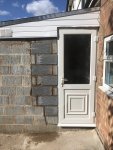Evening all,
I have asingle story building with celcon blocks that I need to render. I’m thinking my options are either making a brush on slurry of sbr, sand, cement, water, wait to dry then scratch coat as normal.
Or would galvanised steel mesh be a better option?
or am I well out and someone here has done a few of these and found something that works? Ratios would be great.
Thanks.
ps, the building has had an alteration after completion hence the odd block work to the left of the door. Not looking for comments on this. Thanks again.
I have asingle story building with celcon blocks that I need to render. I’m thinking my options are either making a brush on slurry of sbr, sand, cement, water, wait to dry then scratch coat as normal.
Or would galvanised steel mesh be a better option?
or am I well out and someone here has done a few of these and found something that works? Ratios would be great.
Thanks.
ps, the building has had an alteration after completion hence the odd block work to the left of the door. Not looking for comments on this. Thanks again.



